Our Peek Inside… series takes a look inside people’s journals to celebrate their imagination and inspire others. This week we are thrilled to welcome Sonya Kinsey, an artist and teacher from Germany who loves anthropology, history, linguistics and travelling, and – of course – drawing and journalling. We were immediately attracted to Sonya’s sketches and drawings of a magical world full of whimsical characters and interesting buildings, and we wanted to learn more about her work. Join us in taking a close look at Sonya’s work inside her Paperblanks notebooks.
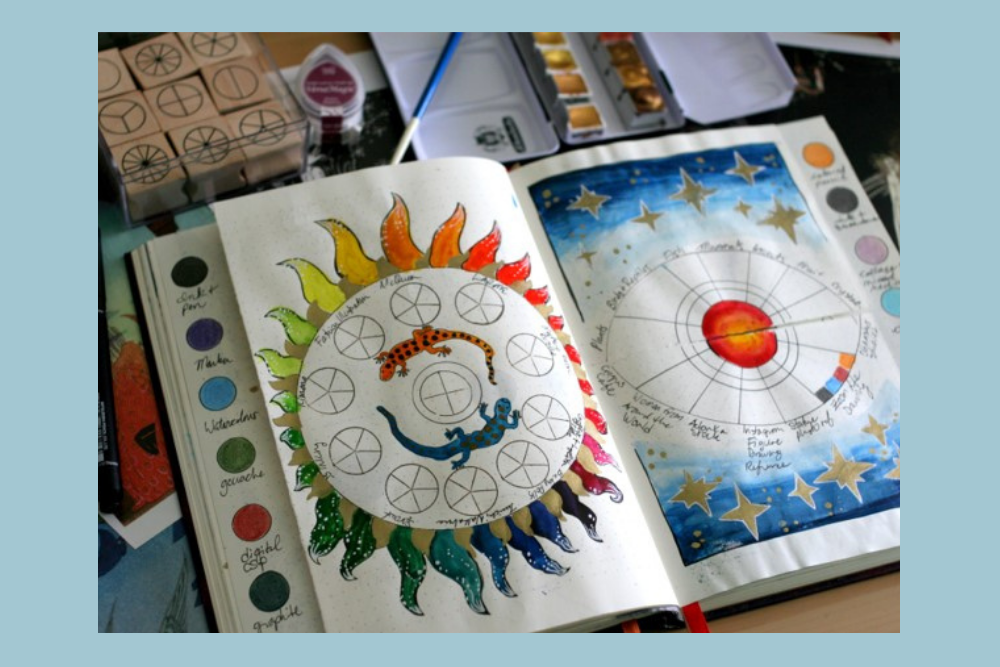
My First Paperblanks
I remember getting my first Paperblanks sketchbook as a teenager, and I’ve had the occasional sketchbook over the years. I often get them as gifts, and no complaints about that! In 2018 I decided to start bullet journaling and needed a journal. I went to a local stationery store in Freiburg to see what was available and the Paperblanks bullet journals had just come out. They were the format that I had been looking for, and I really fell in love with the Safavid cover.
What I Like About Paperblanks
I find them really eye catching. I love the references to historical bookbinding and to the work of other writers and artists. I take my sketchbooks out to do urban and travelling sketching, so having a good hardcover is important. I prefer thread bound sketchbooks to loose sheets and spiral bound. The paper is suitable for a variety of media, especially for ink, and it scans very well. There’s no bleed and very little ghosting and it can handle me working with several layers of blending with brush pens.
My Favourite Subjects to Draw and My Favourite Tools
I’m rather obsessed with drawing humans and horses. I’ve been drawing horses just a bit longer than people! I grew up with horses and whether I’m working realistically or in a more illustrative style, horses are really a wonderful and versatile subject. I also really love drawing the human body. I started figure drawing seriously around age 14, and I’ve learned that human anatomy is truly infinite. Recently, the pandemic has seen a lot of models hold online sessions, and I join in regularly. I do lots of urban sketching. Living in Germany and traveling in Europe has given me the opportunity to sketch a lot of medieval and Art Nouveau architecture, and to understand first-hand how the proportions of architecture and the details of buildings have changed over time. I’m also very influenced by historical costume and fashion design. My mother was a professional seamstress and although I can’t sew nearly as well as she does, I was raised to have an appreciation for clothing from different cultures and for haute couture. My mother taught me embroidery and did textile dyeing. She used to take me along shopping for sari fabric in stores run by Indian women in Calgary. I worked for three years as an English teacher in Seoul, South Korea and learned about Korean traditional clothes. In Germany I’ve learned about the very regionally specific “tracht” or regional traditional clothing. Since I’m a manga reader, I have learned a lot about Japanese traditional and contemporary clothing. I enjoy sketching clothing and patterns from around the world and continuing that sartorial tradition of fashion illustration.
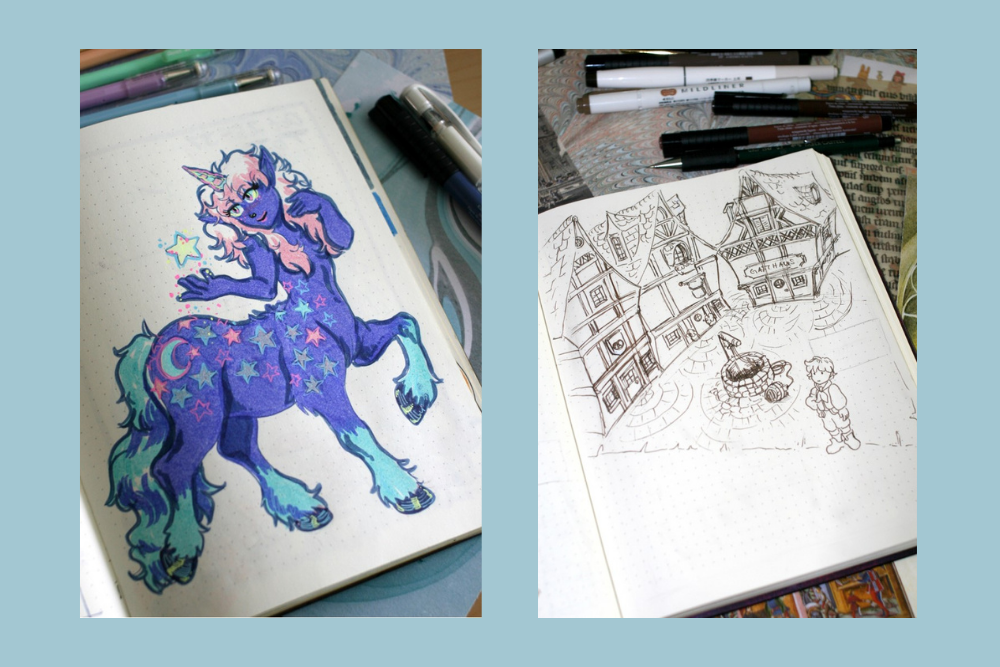
All of this feeds into my work as a comic artist, illustrator and writer. Drawing comics and character design requires a huge base of knowledge and I’m always working to grow that. For my own projects and for freelance work, I need to be able to draw people of all shapes, sizes and colours, and to accurately render or design clothing. There’s also perspective, animals, cars, everything! The first four or five years of drawing is just laying a foundation to continue building the rest of your life.
I work primarily in ink, markers, watercolours, graphite, coloured pencils and digital and frequently mixed media. It’s a long list, but my favorite media are the first three. Ink is an extraordinarily versatile medium that can be used with a fineliner or fountain pen, a nib pen, or a brush or brush pen. Watercolour is a wonderful medium that can take years and a lot of patience to master, but it has a wonderful looseness and clarity that comes from letting the paper shine through as the light source. Markers such a brush pens and alcohol-based markers are versatile tools. You have to know how to layer and blend without letting the pigments muddy, but in the past decade more options have become available at various price points. Paper is also a material I really love for itself. I’m always cutting up magazines and saving ephemera and creating scrapbooks. I have one for each comic project. My favorite pens for writing and sketching are my Lamy and Faber-Castell fountain pens, something I discovered in Germany. Copic and Unipin are great for inking comics and illustrations. For my journals I use a variety of brush pens, including Zebra Mildliners, Faber-Castell Pitt Pens, and Sailor Shikiori brush pens and white Uniball Signo gel pens.
The Biggest Benefit of Keeping a Sketchbook and a Journal
As a practicing artist it’s vital for me to sketch. Sketching is a perishable skill, so it needs to be maintained. Artists should not just aimlessly doodle, but really set goals, work to overcome obstacles and learn observational drawing. Sketching is an important part of an artist’s tool kit and is essential to problem solving.
Journaling lets me try out ideas and just play around with different materials and themes. I do post some pages on my social media, but the art journal is solely for myself, not any client or a project that I want people to subscribe to or purchase. I believe artists should have work that they do for themselves, to relax and have fun. I also have really severe ADHD so a journal helps me organize and reflect on my work. I have a tracker for art study and for various projects. I’m also a full-time teacher, so I don’t always have the energy to do a more complete illustration or ink comic pages. My journal is always there on my desk, easy to access and with no extra setup. I find planning a bit stressful but with my journal it’s relaxing and fun.
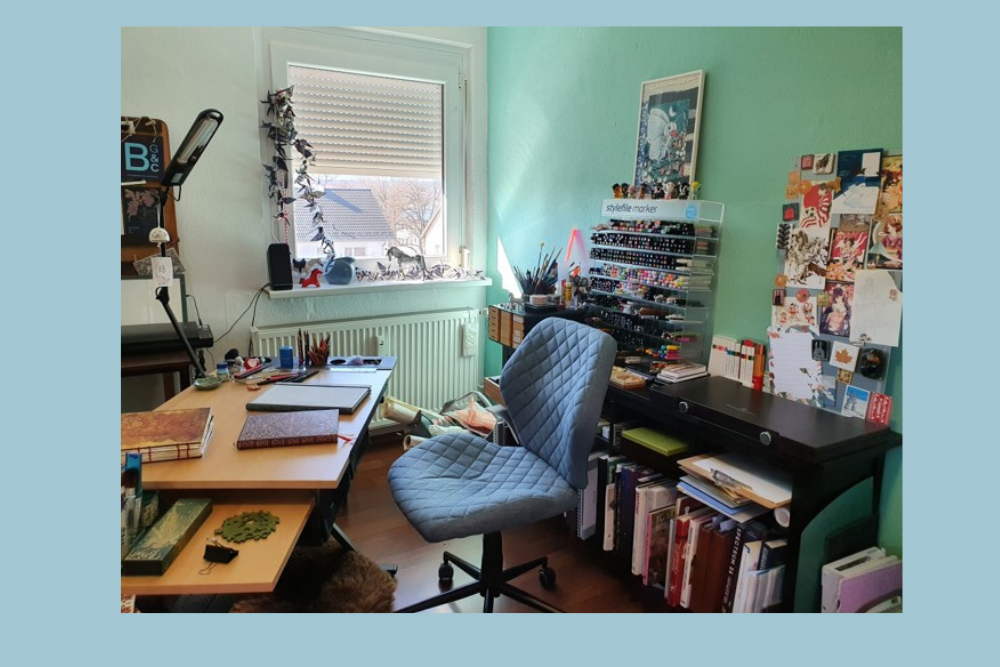
My Advice for Starting a Sketchbook
The first thing I’d say is that art can be thought of as more of a process or a practice, not a result. On social media, it can be easy to be overwhelmed by all the pretty, perfect photos of great sketchbooks. What you don’t see is all the “bad” work done on other pages, or that the artist had to do to get to that level. It takes a lot of time to be good at art. I’ve been doing it thirty years now, and I still make mistakes and sometimes have to redo a face or a background. I’m the artist who is not afraid to throw out old work. Not everything I do is great or has to be monetized for money or even likes on social media. Since I work for clients, I do have to work to a certain standard, but my sketchbook is not for clients. My sketchbook is for me, and it’s a personal narrative of my growth as an artist.
When you start, remember that the first page or even each individual page is not important. It’s the whole book, the whole narrative of your progress that is relevant. Start with a plan. What do you want to learn? How will you learn it? What is your timeline? What are your resources? Set concrete goals in terms of when and how often you draw, and what you draw. Too many people just aimlessly doodle and never push themselves to complete specific tasks. That can be good to do occasionally to relax or brainstorm, but it won’t help you improve on a technical level. Drawing also takes mental stamina so start with short tasks and gradually build your abilities.
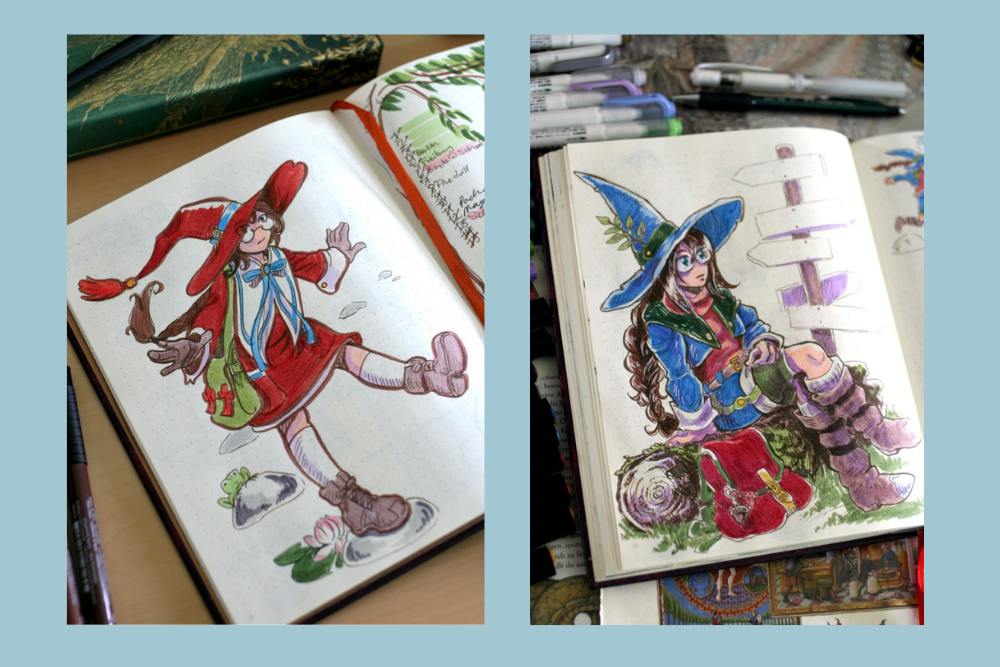
It is, of course, totally okay to be inspired by the work of others and learn from them. Unlike some other fields or hobbies, artists have hundreds of years of knowledge to look back on. Despite the importance of art and design in many industries and fields, artists and their skills are still undervalued and underpaid by society as a whole. Interest in art as a career is often not taken seriously. So, many people don’t realize how much learning and time is involved in drawing well. This means that beginning artists, especially those starting outside of a formal educational program, are often overwhelmed by the huge amount of learning material and discouraged by an apparent lack of progress. It’s important to realize that progress in art happens over months and years, not days and weeks. Don’t plan to be as good as such and such, plan to learn. Don’t try to find your style, or even think about style. Try to build a solid foundation of basic skills and knowledge. You are starting the first sketchbook of many. A lot of people, most people, look at their first sketches and immediately think about how bad they are at drawing. That is normal. When you look back on that first sketchbook, you’ll think about how bad it looks compared to your work now, because you’ve become a better artist. Compare the first page of your sketchbook to the last. Look at the narrative of your process. How did your art and your making art change? So, get that first page drawn and that first sketchbook filled, because you’ll only improve from there.
If you want to learn more about Sonya’s work visit her Instagram page. We are continuously looking for People of Paperblanks to feature on this series. Please send us an email if you have a project that you would like to be featured.

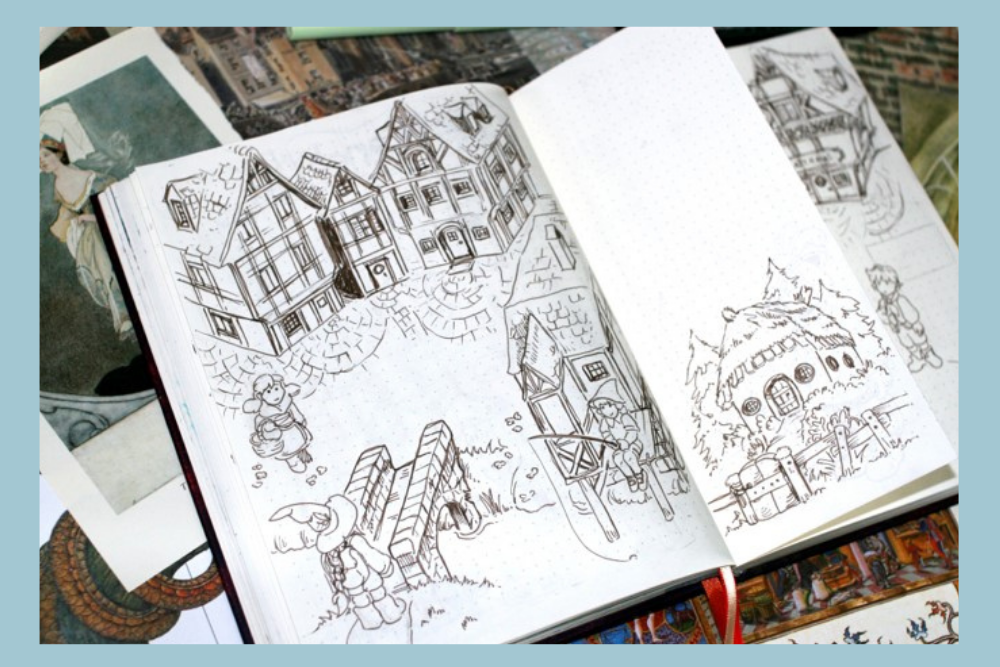



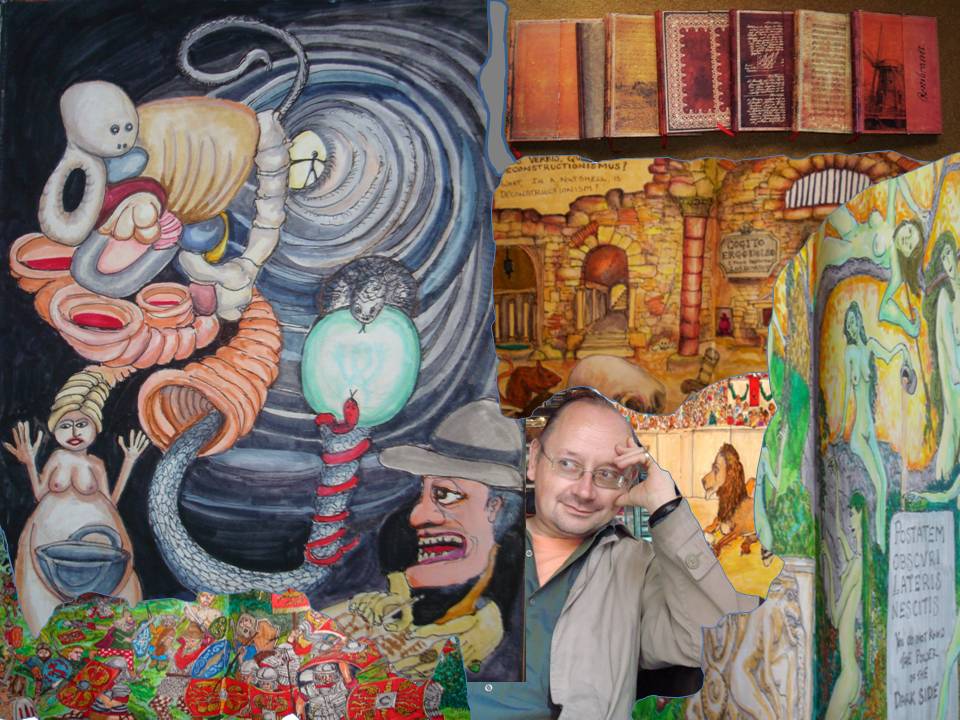
A great and informative article. I follow your work and enjoy it all.
A great and informative article. I follow your work and enjoy it all.